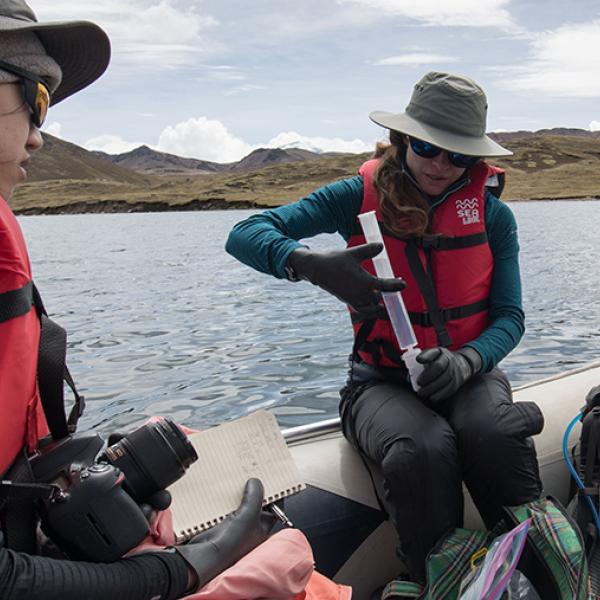Elizabeth Haswell, associate professor of biology and host of The Taproot podcast, wants to change the way that people think about plants. What do scientists know about how plants sense their environment, and what remains a mystery? The answers may surprise you.
Transcript:

Claire Gauen (host): Thanks for listening to Hold That Thought. I’m Claire Gauen. Today on the podcast we’re featuring the work of Liz Haswell.
Liz Haswell (guest): My name is Liz Haswell and I'm a professor of biology at Washington University in St. Louis.
CG: When you hear the word ‘biology’ your mind may immediately jump to the study of animals. But biologist are scientists who study life in all its forms. The type of being that Haswell studies is something that you likely encounter every day but don’t think about too much. She wants to change that.
LH: I want to change how people think about plants.
CG: Plants. Grass, flowers, trees – you get the idea. When is the last time you stopped and really thought about plants? If you’re like many people…
LH: Often they just don't think about them, and then they think about them as sort of shrubbery or salad.
CG: Shrubbery or salad. Decoration or food. In either case, the plant is something to use and enjoy, but not much more than that. It’s so easy to ignore the fact that plants are diverse, complex, and alive.
LH: I want people to know that plants have all of these senses that we just don't see, or think about, because they often happen on a different time scale then we are used to.
CG: By senses, Haswell really does mean what you’re thinking. Take a moment to recall the 5 senses we all learned about in grade school.
"I want to change how people think about plants ... I want people to know that plants have all of these senses that we just don't see, or think about, because they often happen on a different time scale then we are used to."
LH: So our senses are sight, hearing, smell, taste, and touch. Isn't that right? Eyes, ears, nose, mouth, and fingers. Right.
CG: As crazy as it may sound, plants share almost all of these senses. Of course, without eyeballs, ears or noses, their senses work a little differently. Let’s go through the list.
LH: [Plants] do have sight, in the sense that they respond to different wavelengths so they can essentially see colors. They can also smell, so they sense gaseous hormones.
CN: For example, if a caterpillar is nibbling on a leaf, the plant can create a sort of “hey I’m being eaten” signal.
LH: That releases a lot of volatile chemicals that are used to signal to other parts of the plant into other plants. So they can smell. We also think they can kind of hear. That they can actually sense vibration of, for example, caterpillars chewing.
CG: Clearly being eaten is something that might put a plant’s senses into high alert. So we’ve covered sight, smell, and hearing. Three down, two to go.
LH: The one sense that I can't really argue that plants have is taste. I mean you might argue that they know salty, like soil or something, but that's more about nutrition than it is about the pleasure of taste or the displeasure.
CG: Hey, can’t have them all. So now we’ve arrived at the final of the five senses – a sense that has an enormous effect on how human beings live in the world, and also, as it turns out, how plants live in the world.
LH: Most close to my heart is the fact that they can sense touch.
CG: Touch. Here we’ve arrived at Haswell’s area of expertise. It’s a little weird to think about at first, but there are a few obvious examples of how plants do in fact feel their surroundings. First, just imagine a pea plant or any sort of vine growing up a stake.
LH: It knows the stake is there because it can feel that, it's touching it, and it changes the way that it grows. It changes its direction of growth in response to touching the stake.
CG: Think also about the roots of plants. Unless the plant has a cushy life in potted soil, it’s likely that any root burrowing down into the earth is going to come across obstacles.
LH: Like it doesn't make any sense for a root not to know that it's trying to grow right into a rock. It's got to change and grow around it.
CG: Stakes and rocks are both objects that usually don’t move, so a vine or a root would likely touch those things for a long period of time. But what about other forms of touch, the types of things that human skin might feel?
LH: There are also a lot of more subtle touches; we do think that hairs on the leaves let a plant know when an insect is walking on it.
CG: This blew my mind a little bit. If a plant can sense when an insect is walking on it, it stands to reason that a plant can sense when I touch it, right? Could that possibly be true? Can plants feel human touch?
LH: So if you take a flat of plants and you just pet them, just gently, every day for ten days, when they when they finally grow to maturity they will be much shorter.
CG: That’s right. Plants not only feel the touch, they change their growth to react to that touch. According to Haswell, it’s likely that if you pet a plant for days on end, the plant senses that it’s in a continually disturbed environment. Often the reproductive part of a plant is at the end of the stem, at risk of getting knocked off by animals that pass by, so the plant responds by growing shorter and stockier. How this happens is a different question –one that Haswell wants to figure out.
LH: We're sort of interested in 'how does the plant count that?' Because you don't you can't just touch them once and then you see the response — you have to touch them multiple times over multiple days. So how does the plant "remember" that's been touched yesterday or the day before? We think that's really an interesting question. We don't know yet.
CG: When it comes to questions about plants and touch, rocks and insects are really just the beginning. Haswell’s first fascination with how plants respond to force had to do with something much more basic – gravity. Back when Haswell was just completing her doctorate in biochemistry, she knew that she didn’t want to do animal studies as a career. So, she started reading up more on plants, and before long, she came across the idea of gravitropism – that is, growth towards or away from gravity.
LH: So roots grow toward the center of the Earth, and the shoot grows away from it. The thing is, we know a little bit about how that works, but basically so little is known that I just couldn’t believe that we didn’t know how this fundamental process works. How can we not know how a root grows down? That seems crazy that we don’t know it. So I thought, well, I’ll just figure that out, and then I’ll get tenure. That was my idea. [Laughing] That’s not what happened.
"How can we not know how a root grows down? That seems crazy that we don’t know it."
CG: Instead, she opened the door to studying all different kinds of force. Things like the effects of touch on plants that we were talking about earlier, and also, how force works on a much, much smaller scale.
LH: One of the things we're really interested in is that the plant also has to respond to mechanical forces that are intrinsic, or from inside the cell, like osmotic pressure or things that happen during cell division. We know that plant cells actually determine a lot of information about who they are, like what kind of cell they are and where they are within the plant, based on what kind of pressure they're getting from the cells around them. So their context, their mechanical context, gives them developmental identity. This is also true in animal systems, to some degree.
This whole area of study focused on cells, tissues, and physical force is called mechanobiology. Understanding the mechanobiology of plants takes, well, a PhD in biochemistry. Haswell says that plants likely sense force in a bunch of different ways that work together in a complex network. She and her colleagues are figuring out pieces of that puzzle.
LH: We are focused on one type of molecule that super convenient to study, because it both senses and responds to force in the same molecule. That’s these mechanosensitive ion channels.
CG: That was mechanosensitve ion channels. And what exactly is an ion channel, you ask?
LH: So an ion channel is just a protein pore in the membrane that lets ions pass through the membrane in a gated way. So they decide when the pore opens. How a mechanosensitive channel does that is through membrane tension.
CG: To help get your head around this, picture a cell as a balloon. The cell membrane is the actual stretchy balloon part, and the air inside the balloon is the inside of the cell.
LH: When you blow the balloon up, you're increasing tension in the balloon material, and that would be what would open these channels and let ions go either direction.
CG: So the force exerted on the ion channel – think of it as the tension put on a balloon – allows ions to flow either into and out of the cell. Haswell can actually see and measure this process happening in her lab. And it turns out that these mechano-sensitive channels are really important for plant survival.
LH: So we know they're important for certain types of osmoregulation, and we've recently shown that they're important for pollen to survive rehydration, but we know there are a lot of these types of channels in plant genomes that we don't know what they do.
CG: For now, what those channels do is still a mystery – one of many in the world of plant mechanobiology.
LH: We've focused on these channels because they're sort of low hanging fruit, because I love how beautiful they are and the biophysics and biochemistry of them. But my guess is that as we begin to develop more tools for studying plant mechanobiology, we're going to uncover all kinds of new, completely distinct ways for plants to know they're being pushed from the inside or the outside, or vibrated, or whatever. So I think we're just the tip of the iceberg at this moment.
"We've focused on these channels because they're sort of low hanging fruit, because I love how beautiful they are and the biophysics and biochemistry of them. But ... I think we're just the tip of the iceberg at this moment."
CG: Beginning to investigate this giant iceberg takes a big scientific toolbox, one that includes genetic modification. You might think of genetically modified plants in relation to food, but in Haswell’s lab, they are powerful research tools.
LH: We're genetically engineering plants so that we can understand them better. It's genetic modification for research purposes only. We modify everything — we knock genes out, we use CRISPR-cas9 technology to make tiny modifications in genes, we express them at higher levels than normal, we make tiny modifications and express them, we stick fluorescent tags on them. We do everything we can to mess things up, and then see what happens.
CG: For some time, Haswell was one of a relatively few number of scientists doing these kinds of experiments, but interest is growing. Here at WashU, for example, this work is happening in partnership with other universities within the newly created Center for Engineering MechanoBiology.
LH: So NSF funds, every couple of years, these really big science and technology centers. A couple of years ago, University of Pennsylvania and a couple of collaborators here put together a proposal and ended up getting funded to engineer mechanobiology in plants and animals. So there's a bunch of us that are invested in trying to really move the field of understanding the basics of mechanobiology, but also like using what we know to make leaves on a chip, or be able to control plants remotely using mechanical stress, and all these kind of pie-in-the-sky ideas. But the idea is that, by joining forces with a lot of engineers and mathematicians and biologists, we can make this happen.
CG: With exciting prospects like these on the horizon, Haswell sees a future in which people – well, at least scientists – look at a plant and see much more than shrubbery or salad.
LH: More and more people are joining the field. You know, I used to feel like there were just maybe 10 of us in the U.S. who were really working on this, but more and more people —especially in Europe — are joining in on the project. So I think that, in another 10 years, we are going to have some big answers to how all this works.
CG: Many thanks to Liz Haswell for joining Hold That Thought. For more from Liz, be sure to check out her podcast The Taproot. Every episode digs beneath the surface of a recent plant biology paper. If you’re studying plant biology or just have an interest in how science works behind the scenes, be sure to give it a listen! You can find a link on our website, holdthatthought.wustl.edu. Thanks for listening.





